Col. Sudhir Farm

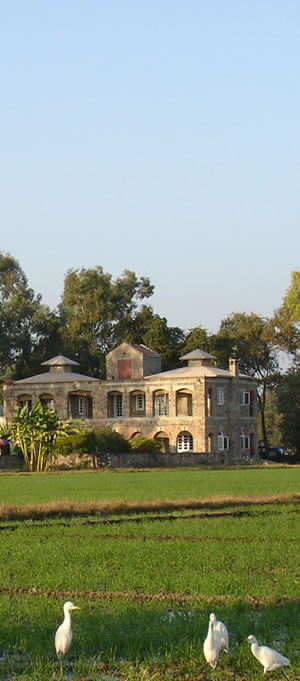


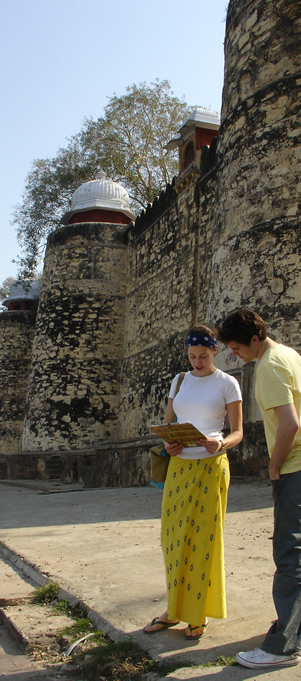

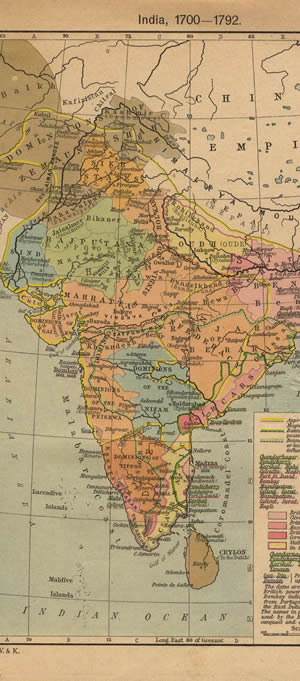
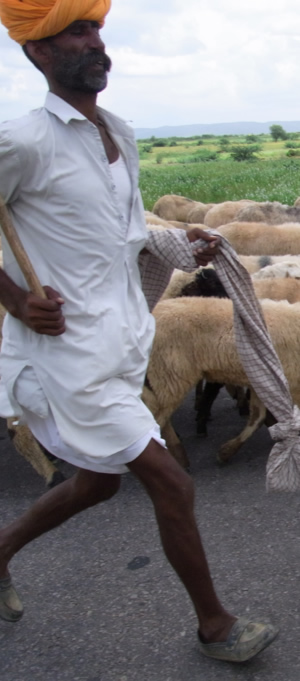
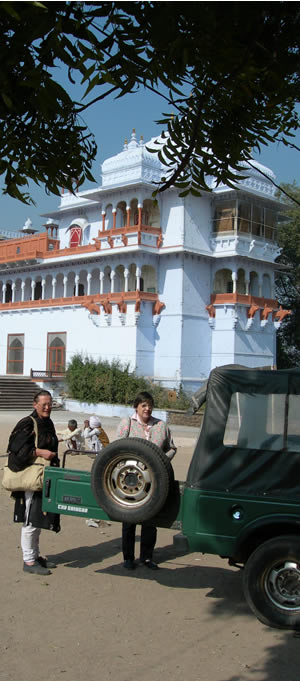
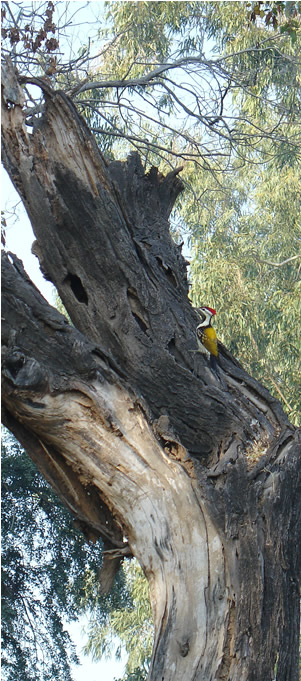
Snippets from the Visitors' Book
The Kota tonga trail was a real highlight - a bit like a 19th Century treasure hunt. It’s full of little nuggets of unusual information and fascinating glimpses into the unsolved mysteries of Kota.
Harriet and Will, London. UK
The memorial to Major Burton and his sons was much more moving than the Taj Mahal or the lake at Udaipur, marvellous as they are.
Henry Vane, Cumbria, UK
...the most comfortable bed I’ve slept in for 2 months....
Charlotte Adam, Winchester UK
Two days out of the noise and the people in a beautiful place. We felt totally
at home
- To be recommended to every person who wishes to experience the Indian country life. We also liked the way the food was prepared...
Patrick & Marie-Christine Lemaigre, Nil-St Vincent, Belgium
We’re only here for the porridge and home made bread! Thank you for a most wonderful time the memories of which we shall carry always. You have given us a wonderful & fascinating introduction to India.
Sue Turner, Lancashire, UK
So ...Rajasthan is not all desert! Thank you for sharing everything with us....
The Read family, London, UK
What a wonderful time we’ve had at the school in the village, at the weavers’, on the river, atop a tonga! Thank you for all your help and contacts throughout India
Anne Gerbner, Philadelphia, USA
It was a wonderful stay and thank you for giving us such a positive look at India and Rajasthan.
Salma Goldstein, New Jersey, USA
- There once was a lady of Kota
- Who took visitors out in her motor
- With the roads and the ruts
- It took quite some guts
- To go out with the lady of Kota.
- But once back at home on the farm
- The world quite descended to calm
- With the plants and the birds
- And fox terriers in herds
- There was balm in the calm on the farm.
Sue Millar, London, UK
After travelling around Rajasthan for two weeks, reaching a real house with books on the shelves, photos on the walls and four happy dogs was simply wonderful.
Camille Savinien, Paris, France
This isn’t tourism. I know of nowhere else where you can experience the real India as well as on your traditional working Rajasthani farm.
Sam Milward, Wellington, New Zealand
Thank you so very much for such a wonderful stay - what a fantastic introduction to India. I don’t think we’ll find such tranquillity elsewhere.
Lizzie Fortune, Hampshire. UK
Fabulous - I’ve been spoilt. It’s hard to leave and face the real world.
Elisabeth Simson, Isle of Wight, UK
After travelling around Rajasthan for two weeks, reaching a real house with books on the shelves, photos on the walls and four happy dogs was simply wonderful.
Camille Savinien, Paris, France
This isn’t tourism. I know of nowhere else where you can experience the real India as well as on your traditional working Rajasthani farm.
Sam Milward, Wellington, New Zealand
Thank you so very much for such a wonderful stay - what a fantastic introduction to India. I don’t think we’ll find such tranquillity elsewhere.
Lizzie Fortune, Hampshire. UK
Our visit at the farm was truly wonderful, off the beaten track it is a slice of India a visitor does not normally experience. Victoria is very knowledgeable about Indian culture and the people - an added perspective for us. The food here was very delicious: organically home grown ingredients, vegetables, fruits, grains prepared simply homestyle. A nice change from curries. Enjoyed the early morning boat ride and walk to the weavers. Many thanks.
Johanna Janssens, Washington, USA
I loved staying with you and the dogs and playing with the toys.
Jonas aged 8, Switzerland
A very welcome break from the crazy world of India – wonderful house, food and hospitality. Thank you so much.
Katie Buxton, Bath, UK
I loved seeing the crocodiles, and I learned a lot about deticking the puppies. Coming to the farm was a great experience.
Stella Bartholet, Washington, USA
A wonderful eye opening visit in every sense. We will be back! Thank you!
Christopher & Joanna Hobson, Northamptonshire, UK
A blissfully peaceful stay. We enjoyed everything – even the power cut. Thank you for lovely food, good company and very interesting trips.
Vicky Stark, London, UK
Exactly what we hoped for and more, bits of India off the tourist track, life as it actually is in villages, teeming life and livestock and the magic of the river.
Sir Hilary Miller, Worcester, UK
Thank you for the introduction to miniature painters, wall paintings, stories, great food, good company, walk through the fields. I loved the paintings in the City Palace and go back full of inspiration and memories.
Nan Mulder, Edinburgh, UK

On the Farm - 2008 Archive
On the Farm - December ’08
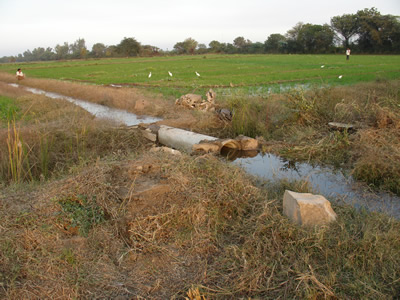 We ploughed in all the mustard that had been planted in early October as germination was poor and re-sowed with wheat. This will be a problem as it all has to be watered three times.
We ploughed in all the mustard that had been planted in early October as germination was poor and re-sowed with wheat. This will be a problem as it all has to be watered three times.
 On a domestic note, Sugna, the maid who works in the house, is seen here proudly holding her grandson born on November 1st. The baby’s mother was thin and weak and the child nearly faded away in front of their eyes as no one seemed to realise that the mother was not producing milk, and the baby did not cry. When I heard it had not passed a stool for six days, I made the young father take the baby to a specialist paediatrician. It was a Sunday afternoon and the father was supposed to be working for a contractor. The baby’s life was saved by being put on cow’s milk and then powdered milk, but the father was sacked for not turning up for work and lost a month’s pay.
On a domestic note, Sugna, the maid who works in the house, is seen here proudly holding her grandson born on November 1st. The baby’s mother was thin and weak and the child nearly faded away in front of their eyes as no one seemed to realise that the mother was not producing milk, and the baby did not cry. When I heard it had not passed a stool for six days, I made the young father take the baby to a specialist paediatrician. It was a Sunday afternoon and the father was supposed to be working for a contractor. The baby’s life was saved by being put on cow’s milk and then powdered milk, but the father was sacked for not turning up for work and lost a month’s pay.
On the Farm - November ’08
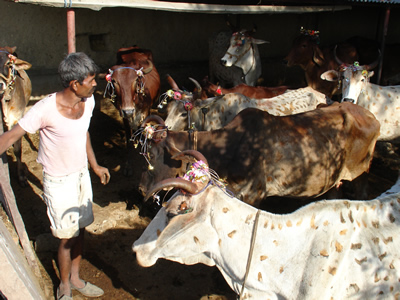 November started two days after the Diwali puja, held to honour the cows as a source of wealth. The cows have been washed, their horns painted with linseed oil and henna, and their coats rather crudely daubed with henna. Since the cows have to stay in now as the fields are sown, I needed to reduce their numbers. I gave away ten large healthy animals to various people as there is no cattle market in India where cow’ are sacred and their slaughter is banned.
November started two days after the Diwali puja, held to honour the cows as a source of wealth. The cows have been washed, their horns painted with linseed oil and henna, and their coats rather crudely daubed with henna. Since the cows have to stay in now as the fields are sown, I needed to reduce their numbers. I gave away ten large healthy animals to various people as there is no cattle market in India where cow’ are sacred and their slaughter is banned.
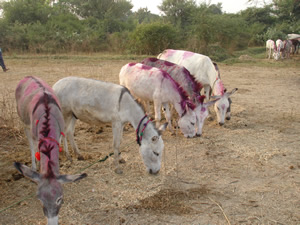 November is the month in which the famous camel fair is held in Pushkar. Near to us, a donkey fair or mela is held one kilometre from our farm at the same full moon known as Karthik Purnima. Each year there are significantly fewer donkeys and mules for sale.
November is the month in which the famous camel fair is held in Pushkar. Near to us, a donkey fair or mela is held one kilometre from our farm at the same full moon known as Karthik Purnima. Each year there are significantly fewer donkeys and mules for sale.
On the Farm - October ’08
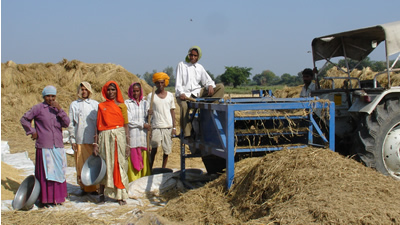 The paddy was hand-cut, and hand-threshed by being flailed against an oil drum to separate the grain from the stalks by the labourers from Bihar, generally referred to as the Biharis. It was then put through a winnowing machine by a local gang comprising mainly women. An interesting point about this photograph is that the job of feeding the paddy into the machine has been assumed by the woman contractor. As it involves sitting astride the machine, she has adorned tough men’s trousers. She changed back into a sari to walk home.
The paddy was hand-cut, and hand-threshed by being flailed against an oil drum to separate the grain from the stalks by the labourers from Bihar, generally referred to as the Biharis. It was then put through a winnowing machine by a local gang comprising mainly women. An interesting point about this photograph is that the job of feeding the paddy into the machine has been assumed by the woman contractor. As it involves sitting astride the machine, she has adorned tough men’s trousers. She changed back into a sari to walk home.
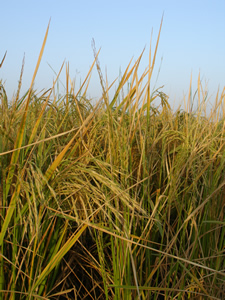 This is ripe paddy, a variety of basmati. From 100 kgs. of grain one gets about 50 kgs. of whole grain basmati rice. The rest is husk and broken bits of rice.
This is ripe paddy, a variety of basmati. From 100 kgs. of grain one gets about 50 kgs. of whole grain basmati rice. The rest is husk and broken bits of rice.
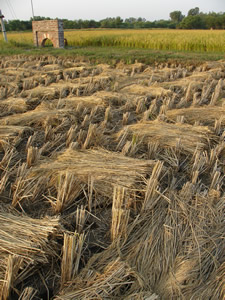 This shows how neatly the rice is hand-cut and methodically laid out to dry before being gathered into huge piles on a tarpauline for threshing. Half the farm was planted with mustard.
This shows how neatly the rice is hand-cut and methodically laid out to dry before being gathered into huge piles on a tarpauline for threshing. Half the farm was planted with mustard.
On the Farm - September ’08
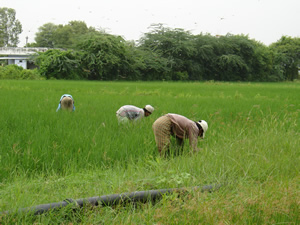 The Bihari boys in their baseball caps are weeding the rice; this has to be done twice. It is more cost effective using labour from Bihar than the local farm women who arrive for work at 09:30 - 10:00 a.m. and achieve very little in a day. (There has been a lot of trouble in Maharashtra where the right-wing Hindu ruling party has encouraged people to drive out cheap imported ‘foreign’ labour i.e. Biharis.)
The Bihari boys in their baseball caps are weeding the rice; this has to be done twice. It is more cost effective using labour from Bihar than the local farm women who arrive for work at 09:30 - 10:00 a.m. and achieve very little in a day. (There has been a lot of trouble in Maharashtra where the right-wing Hindu ruling party has encouraged people to drive out cheap imported ‘foreign’ labour i.e. Biharis.)
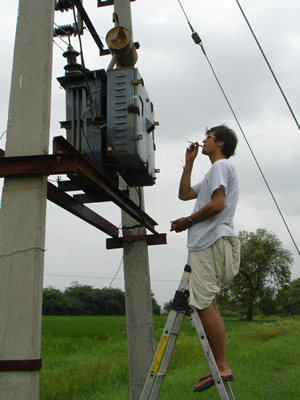 Anand in dhoti is trying to read the new meter. It is digital and the figures do not show up in a power cut, which is when the meter reader usually comes. As the meter reader does not have his own ladder he has no way of reaching the transformer which now houses the meter so that electricity cannot be stolen from between them. If it is raining, he doesn’t like to go up a metal ladder either and so usually writes down ‘locked’ or makes up a reading. We have delivered our own reading to the electricity board which has sent shock waves through the Electricity Department and totally unnerved everyone there.
Anand in dhoti is trying to read the new meter. It is digital and the figures do not show up in a power cut, which is when the meter reader usually comes. As the meter reader does not have his own ladder he has no way of reaching the transformer which now houses the meter so that electricity cannot be stolen from between them. If it is raining, he doesn’t like to go up a metal ladder either and so usually writes down ‘locked’ or makes up a reading. We have delivered our own reading to the electricity board which has sent shock waves through the Electricity Department and totally unnerved everyone there.
On the Farm - August ’08
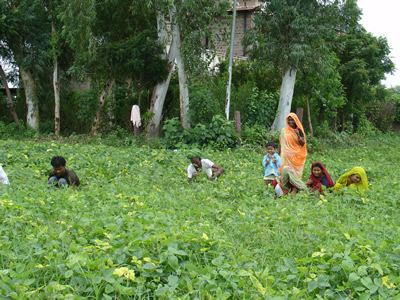 This year the local daily labour rate has increased from Rs.50 to Rs.80 (�1). These workers all live on my farm and I couldn’t get any village labour to come. The man in black on the left is Bhaironlal and his father is wearing the green turban. The little girl, Parvati, is not supposed to live on my farm but prefers being with her grandmother who is standing next to her. She has started school in the village and is wearing her school skirt. Her mother, Manju, is in red and looking at the camera. The young bride, Seema, has her face covered in the presence of her father-in-law; she is now pregnant. One of Manju’s sisters is in yellow. Her other sister is minding Parvati’s baby brother back at the house.
This year the local daily labour rate has increased from Rs.50 to Rs.80 (�1). These workers all live on my farm and I couldn’t get any village labour to come. The man in black on the left is Bhaironlal and his father is wearing the green turban. The little girl, Parvati, is not supposed to live on my farm but prefers being with her grandmother who is standing next to her. She has started school in the village and is wearing her school skirt. Her mother, Manju, is in red and looking at the camera. The young bride, Seema, has her face covered in the presence of her father-in-law; she is now pregnant. One of Manju’s sisters is in yellow. Her other sister is minding Parvati’s baby brother back at the house.
It rained very heavily on some days and the labour would be sent home as too much soil comes up with the roots of weeds if the ground is sodden. The village women could earn a full day’s wage in the rice fields despite heavy rain and so preferred to work there.
On the Farm - July ’08
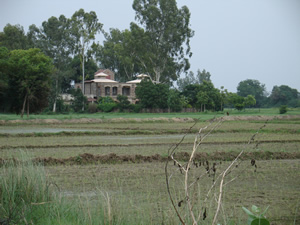
 This year for the first time we have grown rice, in answer to the world shortage and the need to make some money. It means spraying with insecticide which we have not done for the last 12 years. The rice was planted in a nursery in May and then transplanted by hand by a team of Bihari labourers in July. The pump is pumping out ground water 24 hours a day to keep the fields flooded. The farm looks like Kerala.
This year for the first time we have grown rice, in answer to the world shortage and the need to make some money. It means spraying with insecticide which we have not done for the last 12 years. The rice was planted in a nursery in May and then transplanted by hand by a team of Bihari labourers in July. The pump is pumping out ground water 24 hours a day to keep the fields flooded. The farm looks like Kerala.
On the Farm - June ’08
I engaged a new hali (farm worker) Bhaironlal, who had migrated from an interior village to Kota looking for work. He and his wife aged about 18 and his very old looking father had been living in a small pumphouse. He is used to driving a bullock cart and can milk cows. The wife of the previous hali, Shankar Lal, had had yet another baby and he moved back to his village hoping to get work there. He was very vague as to how many children he had and claimed five or six. Halis are employed for a year and demand most of their salary in advance. There seems no way to break out of this system and might even be illegal if interpreted as bonded labour. I would prefer to pay them monthly, but they will not have any of it.
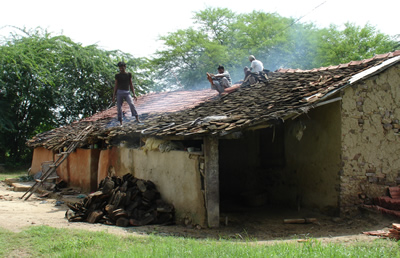 The cowshed roof has been leaking for sometime and I bought Rs.5000 worth of manufactured angrezi (English or foreign) tiles to replace the old hand made and picturesque local ones which are no longer available. The multi-toned colour of tiled village roofs will be a sad loss aesthetically but hopefully the inhabitants will be dryer. The smoke coming through the roof is from cooking and not part of the process of changing tiles. Each tile is kept in place by the weight of the one above it. They are laid on brushwood on top of rough planks sawn locally from our farm eucalyptus trees. The planks are not treated against white ants and last only three years in some cases. As the angrezi tiles are heavier than the traditional ones, the wood planks have to be stronger than formerly.
The cowshed roof has been leaking for sometime and I bought Rs.5000 worth of manufactured angrezi (English or foreign) tiles to replace the old hand made and picturesque local ones which are no longer available. The multi-toned colour of tiled village roofs will be a sad loss aesthetically but hopefully the inhabitants will be dryer. The smoke coming through the roof is from cooking and not part of the process of changing tiles. Each tile is kept in place by the weight of the one above it. They are laid on brushwood on top of rough planks sawn locally from our farm eucalyptus trees. The planks are not treated against white ants and last only three years in some cases. As the angrezi tiles are heavier than the traditional ones, the wood planks have to be stronger than formerly.
On the Farm - May ’08
The irrigation department gave contracts for the ‘tail end’ of the system to be lined with stone and cement and so during the hottest weather when water for curing the cement was in short supply, gangs of labourers toiled in the sun. Some trees along the boundary where the small irrigation channel runs had to be cut down, partly for this reason and partly to deter troops of langur monkeys from crossing the land using the safety of the trees. The contractor skimped on cement and the finished walls could be kicked down. Luckily, we had refused this ‘free service’ inside the farm. A badly made channel is very expensive to maintain. An earth one can be mended easily but needs a lot of labour to clear the weeds.
On the Farm - April ’08
We had very heavy rain for several hours on 4th. This was unprecedented. We were lucky that our standing crops were not hit by the enormous hail stones that destroyed crops in West Rajasthan but the ripening grain was a lighter colour. ‘Colour fade hogaya’ as the local expression was. Because of this, I lost 10% on the price.
Most of April was taken up with trying to queue jump so that the combine harvester would come earlier than booked. Other people were better at this than I was and it finally reached us 4 days late. It was also hard this year to find women to cut the remaining grain by hand but the weather continued ‘saaf’ or clean, and the harvest was safely gathered in
This photograph shows the combine harvester in action. In the foreground, in contrast, one can see women cutting wheat by hand.
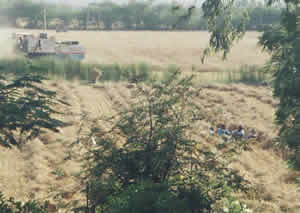
There was such a bumper crop that the grain market closed for two days at a time to clear the backlog. We sold to the government at their minimum support price which had been substantially raised to prevent private parties speculating in grain just before an election year. The open market price was actually less than the MSP as the speculators held back. I also sold 122 quintals to local people, from a pile of grain next to the house. They had to provide the sacks, string for sewing up the bag, and the labour. I weighed.
Export of wheat has been banned ahead of next year’s election, which also serves to stop the price approaching world grain prices. Rs.1000 ⁄ quintal, about £13 was only 3% up on last year but 30% up in two years. Last year India bought massively on the world market causing people to panic but this year they shouldn’t have to. They still face the problem of how to get it to those who can’t afford it. There are registered poor people with BPL (below poverty level) cards but the system is widely abused. Since some states cap the figure of BPL card holders, the genuine poor don’t make it to the list at all.
The yield was good, however, and we ended the month waiting for the cheques to come from the government.
On the Farm - March ’08
We had a litter of puppies born on 1st March.

In preparation for a long hot summer, I invested in a new inverter system. This is basically two tractor batteries that live outside. They charge when the electricity is running and provide power and light for up to a few hours, when it is not. The fridge and geyser are bypassed but the computer is backed up seamlessly.
The mustard was cut and threshed before Holi on March 22nd. I had no women singing and dancing this year as my maid, who is one of the few left who knows these songs, was recovering from an operation. Village folk culture is disappearing very fast.
We just managed to thresh the mustard before it rained on Easter Day, March 23rd. 41 quintals i.e. 4100kgs were sold at Rs2671, roughly £34 a quintal. This is a 70% increase on last year and reflects the price rise in cooking oil. It now takes more than a day’s labour to pay for 1 litre of cooking oil.
Irrigated agricultural land in India is very precious but is fast being divided up into housing plots against all planning regulations and common sense.
On the Farm - February ’08
There was an unexpected cold spell in early February (19°C ⁄ 9°C) At one point, Kota was colder than London. The cold prevented the usual swarms of aphids on the mustard and gave us an excuse to light log fires in the drawing room.
The Irrigation Dept. came to survey the water channels and promised to line them with cement in April. The loss of water due to poor maintenance of the system is enormous. A lot of damage is caused by wallowing buffalo which are illegally grazed at night around the ‘minor’ water channel bringing water to our farm. As farmers upstream tend to block off our water at night, the men prefer to water the crops from the tubewell using a series of plastic PVC pipes which are clamped together and can take the water to just where it is needed rather than having to route it through a previously watered section. Mustard requires to be watered twice and wheat three times after sowing. The land is also flood irrigated before sowing as rainfall is no longer sufficient.
Canal water is very cheap and is charged according to the crop being grown. In an irrigated area one pays whether the canal is running or not and some people are pumping out vast quantities of ground water from their private borings to sell. In water deficient areas, the only way to augment the water available is to practice water harvesting by building small dams and by banning private borings which lower the water table and cause the hand pumps to run dry.
Irrigated agricultural land in India is very precious but is fast being divided up into housing plots against all planning regulations and common sense.
On the Farm - January ’08
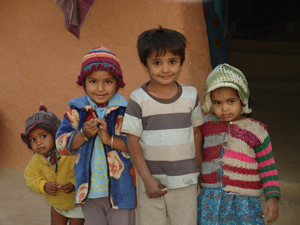
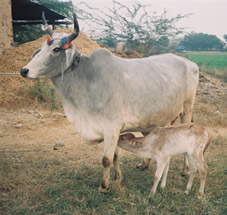 This is our coldest month. The farm children live in little bonnets. A boy born in December is never seen outside. He is brother to Parvati, the biggest girl in the photograph.
This is our coldest month. The farm children live in little bonnets. A boy born in December is never seen outside. He is brother to Parvati, the biggest girl in the photograph.
A calf was born and named Moomal, after a legendary princess from Jaisalmer.
The young wheat grows almost as you watch. The cows have to live inside as all the land is now planted. When the mustard is harvested, the cows will be able to graze in the stubble of the mustard fields - but that will be in March. As for now they eat barsi (a green crop like alfalfa), which is hand cut and given to them. The non-milking cattle are fed jowar.
The main farming activity of the month is watering the mustard crop and the young wheat.

